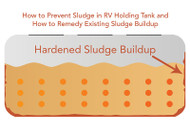How to Prevent Sludge in RV Holding Tank and How to Remedy Existing Sludge Buildup
Posted by Happy Campers Store on Jul 1st 2025
Understanding and Preventing Sludge Buildup in RV Holding Tanks
RV ownership offers the freedom to explore the great outdoors, but it also comes with the responsibility of maintaining your vehicle, particularly the holding tanks. One common issue RV owners face is sludge buildup in these tanks. In this post, we will delve into what causes sludge buildup, how to prevent it, and what to do if you already have sludge in your holding tank.
What Causes Sludge Buildup in RV Holding Tanks?
Sludge in RV holding tanks is primarily a mixture of waste, toilet paper, and other organic materials that accumulate over time. Several factors contribute to this buildup:
- Inadequate Flushing: If the tank is not flushed thoroughly after use, waste can settle at the bottom, leading to sludge formation.
- Low Water Usage: Insufficient water during flushing can prevent waste from breaking down properly, allowing it to accumulate.
- Long Storage Periods: When an RV is not used for extended periods, waste can decompose and create sludge.
- Improper Tank Treatments: Some treatments may not effectively break down waste, leading to accumulation.
How to Prevent Sludge Buildup in Holding Tanks
Preventing sludge buildup is essential for maintaining a clean and functional RV holding tank. Here are some effective strategies:
- Thorough Flushing: Always flush the tank thoroughly after each use. Use plenty of water to help break down waste and prevent it from settling.
- Maintain Adequate Water Levels: Keeping enough water in the tank helps keep waste in suspension, preventing it from settling and forming sludge.
- Use Quality Holding Tank Treatments: Regularly use a reliable holding tank treatment, such as Happy Campers RV Holding Tank Treatment. These treatments are designed to prevent sludge buildup in already clean tanks by breaking down waste and controlling odors. However, it’s important to note that these treatments do not remove existing sludge; they are preventive measures.
Why RV Holding Tank Treatments Can’t Clean Existing Sludge Buildup
If your RV holding tank already has hardened waste buildup you might assume that dropping in a tank treatment will dissolve the problem. Unfortunately, that's a common misconception.
Treatments Are Preventative, Not Restorative
Most RV holding tank treatments—whether they're enzyme-based, bacteria-based, or even mineral-based—are designed to prevent sludge from forming by breaking down fresh waste as it's added to the tank. They work best when used regularly as part of a proper maintenance routine that includes adequate water usage and frequent dumping.
Once waste has settled, compacted, or dried onto the bottom or sides of your tank, these treatments become largely ineffective.
Why They Don’t Work on Existing Sludge
Here's why tank treatments can’t “clean” hardened buildup:
-
Lack of Contact: Sludge buildup is often stuck to the tank floor or walls, far from the active treatment solution floating in the tank water.
-
Time Limitations: Enzymes and bacteria need time to digest organic material, but holding tanks are usually emptied within days—not weeks.
-
Biological Limits: Treatments can break down soft organic matter, but they can’t penetrate or rehydrate dried-out, layered, or compacted waste—especially if it's mixed with toilet paper, calcium scale, or chemical residues.
What If You Already Have Sludge Buildup in Your Tank?
If you discover that sludge has already built up in your RV holding tank, there are several steps you can take to clean it:
- Rinsing with Wands: Use a tank rinser wand to spray water into the tank. This can help dislodge some of the sludge and flush it out.
- Power Flushing: If available, a power flush system can provide a more thorough cleaning by using high-pressure water to remove sludge.
- Using a Tank Cleaner: For existing sludge, consider using a specialized tank cleaner, such as Happy Campers Extreme Cleaner. This product is formulated to break down and remove sludge effectively.
- Professional Service: If the sludge buildup is significant and the above methods do not resolve the issue, it may be best to consult a professional RV service technician. They can provide a thorough cleaning and ensure your holding tank is in optimal condition.
Conclusion
Understanding the causes of sludge buildup in RV holding tanks and implementing preventive measures is crucial for maintaining a clean and functional RV. While holding tank treatments can help prevent sludge in clean tanks, they do not remove existing sludge. If you find yourself dealing with sludge buildup, using rinsing wands, power flushing, or specialized tank cleaners can help restore your tank's cleanliness. In severe cases, seeking professional assistance may be the best option. By taking these steps, you can enjoy your RV adventures without the hassle of tank issues.


